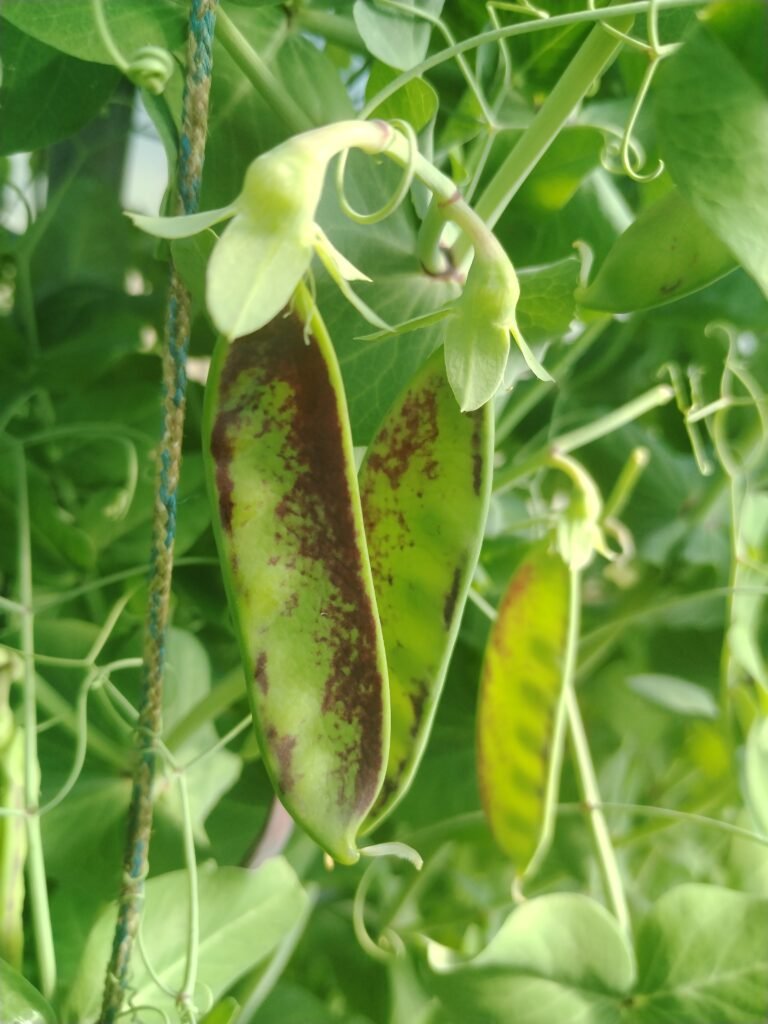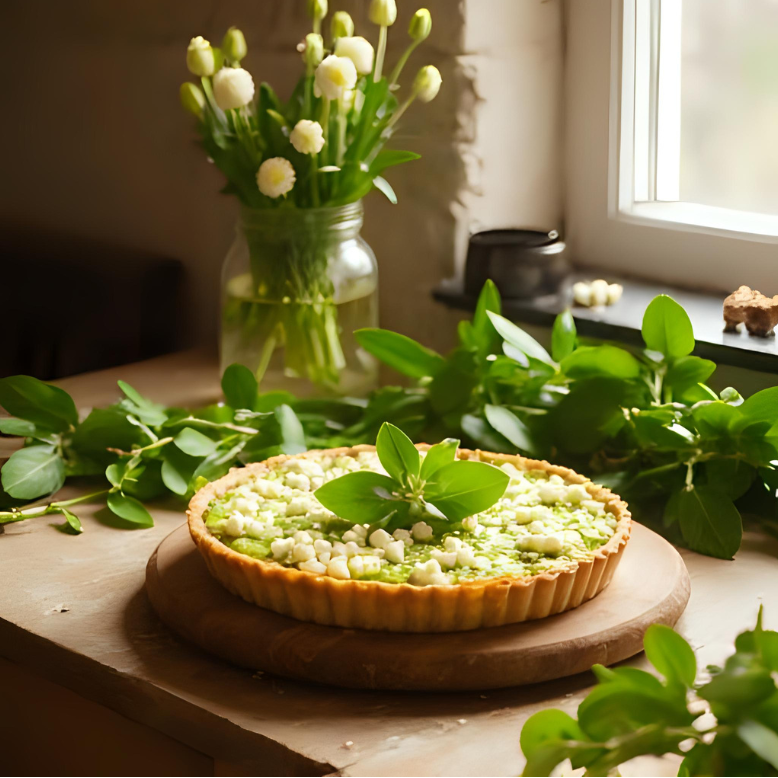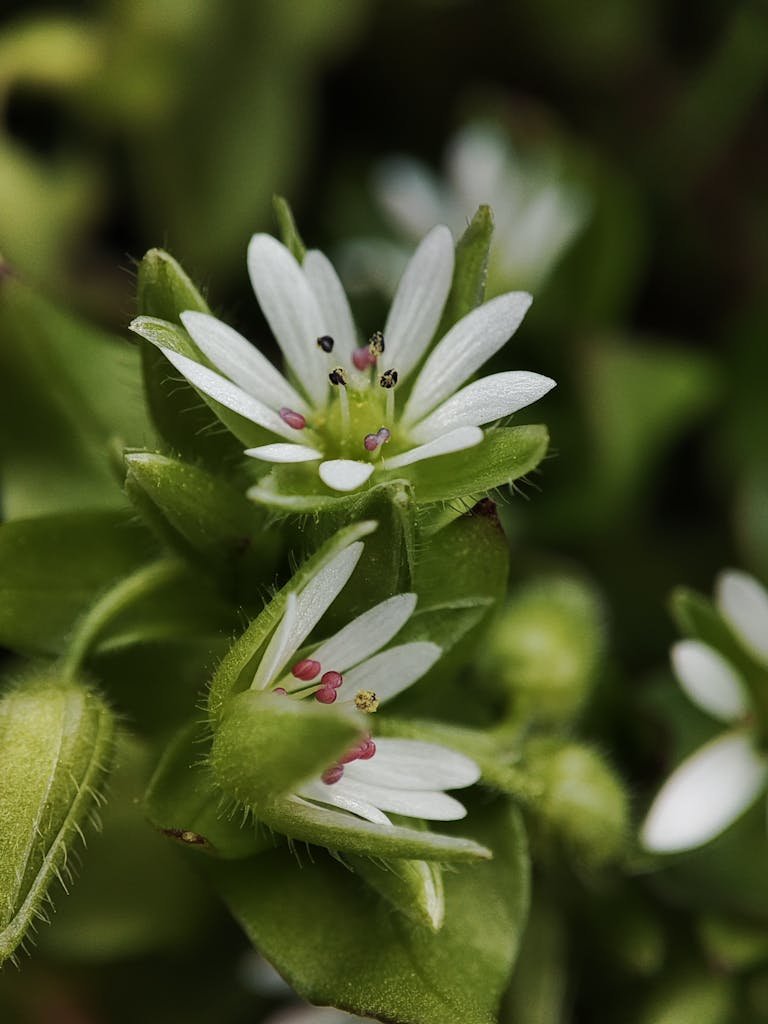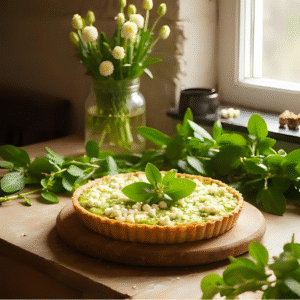


Chickweed is always one of the first to show up in spring — a soft, green reminder that the world is waking up again. This chickweed and pea tart recipe began as a way to make peace with weeding. Because, truth be told, weeding is not my favorite job. It’s fiddly and endless, and some days I’d rather just let it all grow wild.
But chickweed… well, chickweed is different.
It’s not as stubborn as nettles or as bold as dandelions. It doesn’t bite back or dig in. Instead, it creeps gently across the soil, trailing low and leafy, soft enough to pinch between your fingers. If you don’t keep an eye on it, it will take over — but not in a mean-spirited way. It just loves to grow.
One spring, while yanking out a tangled patch before planting peas, I paused. The chickweed was lush and healthy, and I remembered something: it’s edible. Not just edible, but tasty — slightly grassy, with a hint of corn silk. So I kept pulling, but this time with a basket beside me.
That little shift — from weeding to harvesting — made all the difference. Suddenly, I wasn’t doing chores. I was gathering. And I was thankful, too. Thankful for food that didn’t need sowing, for nature’s quiet generosity, for weeds that aren’t just weeds at all.
This tart is a way to say thank you. It’s simple, it’s green, and it tastes like the very start of spring.
Why Cook with Foraged Greens in Spring?
Spring foraging feels like opening a window after a long, stuffy winter. The world smells green again. The first wild greens—like chickweed, nettle, and cleavers—are full of life and energy, and that energy passes right into us. These early leaves haven’t been stressed by sun or bugs yet. They’re tender, clean, and packed with nutrients. Honestly, they feel like the earth’s way of saying, “Here, you’ll need this.”
For beginners, spring is the best time to start. Plants are easier to spot when the landscape is still bare. Chickweed carpets low corners. Nettles rise in bunches like shy soldiers. There’s less risk of confusing them with lookalikes, and less to battle through as you learn.
Cooking with foraged greens isn’t just about eating, either. It’s a way of slowing down. Of living with the seasons. Of letting your meals reflect the hedgerow and not the supermarket shelf. There’s something romantic about it, really—harvesting your own wild salad, your own soup greens, your own bright bites for tart or toast.
The flavors are a little more wild, too—earthier, herbier, with notes of green pepper or lemon or even cucumber, depending on the plant. They add character and freshness that cultivated greens can’t always offer.
So, if you’re tempted to try foraging this year, spring is your soft start. It’s easy, safe, and deeply rewarding—like making friends with the land just as it’s waking up.
Foraging Tips for Beginners
When you’re first starting out with foraging, it can feel a little overwhelming — but that’s completely normal. Luckily, spring makes things easier. The leaves are still young, the ground is soft, and the plants haven’t grown too wild yet. Even so, there are a few simple tips (and a few tools) that will help you get started with confidence and care.
First of all, always be 100% sure of what you’re picking. That might sound scary, but you don’t have to learn everything at once. Instead, start with just one or two plants — like chickweed or dandelion — and get to know them really well. A good field guide is worth its weight in gold, and many of them are pocket-sized and waterproof — perfect for muddy hands and wild weather. (Affiliate link here)
Next, let’s talk gear. You don’t need much, but a few basics make foraging easier and more enjoyable:
- A foraging knife or folding garden snips for clean, careful harvesting (Affiliate link)
- A woven basket or cloth bag to let the greens breathe (Affiliate link)
- Gardening gloves, especially if you’re gathering near nettles (Affiliate link)
- A small notebook or phone app for plant ID and notes (Mention or link)
Also, remember to forage gently. Only take what you need, and always leave plenty behind for wildlife and the plant to grow again. That way, you’re not just harvesting — you’re participating. You’re becoming part of the ecosystem in a thoughtful, respectful way.
Avoid roadsides and sprayed fields. Instead, stick to clean, wild places—your garden, a quiet hedge, or a trusted organic spot. And of course, wash everything well when you get home.
Finally, be patient. Foraging is like learning a language. At first, it sounds like noise. But with time, it starts to make sense. And once it clicks, every walk becomes an adventure, and every weed might just be dinner.
The Top 3 Plant ID Apps for Spring Foraging
When you’re out in the garden or along a country path, it helps to have a little plant expert in your pocket. That’s where plant ID apps come in! These clever tools can help you tell the difference between a patch of chickweed and a patch of… something you really don’t want in your tart. 😉 And even better? Some of them are totally free.
Here are my top 3 picks for spring foraging — whether you’re just getting started or have a basket full of wild greens already.
- PlantSnap 🌿
This app identifies over 600,000 plants from around the world. It’s super easy to use — just snap a photo, and PlantSnap does the rest. It also offers a premium version with extra features if you want to dive deeper. If you like apps with a big database and solid accuracy, this one’s for you. - PictureThis 📸
PictureThis is known for its spot-on plant ID skills and even helps diagnose plant problems. Perfect if you want to learn not only what your plants are but how to care for them. While it doesn’t have an affiliate program, it’s a great recommendation for your readers. - PlantNet 🌱
This one is free and community-driven, making it ideal for identifying wild plants, especially in Europe. It’s easy to use and especially helpful for beginners who want to forage safely. Plus, it’s great at identifying chickweed and other common spring greens.
Using these apps makes foraging feel less like guesswork and more like an adventure. Plus, they help you stay safe by spotting poisonous look-alikes. So next time you’re out, keep your phone handy and start snapping!
All About Chickweed: The Humble Supergreen
How to Identify Common Chickweed (Stellaria media)
First things first, knowing what chickweed looks like is essential before you start harvesting. Chickweed, or Stellaria media, is a low-growing plant that spreads quickly. You’ll notice its sprawling habit, often forming a soft green carpet on your garden soil or along hedgerows. But don’t be fooled—this little green is packed with goodness!
Key Features: Small Star-Shaped White Flowers, Juicy Stems, Opposite Leaves
Next, look closely at its delicate white flowers. They are tiny and star-shaped, often with five deeply split petals that sometimes look like ten—quite charming! The stems are smooth and juicy, almost translucent, with pairs of small oval leaves arranged opposite each other along the stem. These features make chickweed easy to spot once you know what to look for.
Are There Different Types? Overview of Similar Species
Interestingly, while Stellaria media is the most common chickweed, there are a few related species you might encounter. Some look quite similar, like mouse-ear chickweed, which has fuzzier leaves and no flowers. Knowing these differences can help you forage safely and avoid confusion.
Health Benefits: Rich in Vitamins A, C, and Magnesium; Anti-Inflammatory Properties
Beyond its gentle appearance, chickweed is a nutritional powerhouse. It’s rich in vitamins A and C, magnesium, and antioxidants. Many herbalists praise chickweed for its anti-inflammatory effects, making it a soothing addition to salads or teas. So, when you eat chickweed, you’re not just enjoying fresh greens — you’re nourishing your body in a natural way.
Where It Grows: Hedgerows, Pots, Vegetable Beds — Often Considered a Weed
You might find chickweed growing just about anywhere. It loves hedgerows, garden beds, and even pots on your windowsill! Though often dismissed as a pesky weed, chickweed is actually one of spring’s first edible wild greens. It’s a gentle reminder that nature’s gifts sometimes grow right under our noses.
Poisonous Lookalikes to Watch For (e.g., Scarlet Pimpernel, Euphorbia)
However, a word of caution: always double-check what you pick. Some plants, like scarlet pimpernel or certain euphorbias, might look similar but aren’t safe to eat. Using a good plant ID app or guide can help you steer clear of these lookalikes, keeping your foraging both fun and safe.
How to Harvest, Store, and Eat It (Raw or Cooked)
Finally, when it comes to harvesting, pick the young, tender shoots for the best flavor. Chickweed is delicious raw in salads or sandwiches, offering a mild, fresh taste. You can also gently steam or stir-fry it to add a green boost to your meals. For storage, wrap it lightly in a damp cloth and keep it in the fridge for up to a few days. Quick use is best to enjoy its freshness.
Peas in Spring — Quick Guide for Early Crops
Varieties for Early Yield: Meteor, Douce Provence, Early Onward
When it comes to peas, choosing the right variety can make all the difference if you want an early harvest. Varieties like Meteor, Douce Provence, and Early Onward are well-loved for their quick maturity and reliable yields. These pea types are perfect for those eager to enjoy fresh peas as soon as spring arrives — no waiting around!
Growing Tips for Quick Harvest: Sow Under Cover in Late Winter
To get a jump start on your pea crop, try sowing your seeds under cover in late winter. Using cloches or cold frames helps protect the young plants from chilly nights and encourages faster growth. With this little extra care, you’ll be snacking on fresh peas weeks ahead of the usual outdoor sowing schedule. Plus, peas don’t like their roots disturbed, so sowing directly where they’ll grow is key.
Best Uses for Pea Shoots and Pods in Early Spring Cooking
Did you know those tender pea shoots and young pods are culinary gold? Pea shoots make a delicious, crunchy addition to salads or a quick stir-fry, adding a fresh, sweet flavor. Early pods are perfect for steaming or tossing into spring risottos and pasta dishes. Using every part of your pea plant helps you savor spring’s bounty fully — nothing goes to waste!
Where to Buy Fresh Peas if Not Growing Your Own
If growing peas isn’t an option this season, no worries. Many farmers’ markets and local grocers offer fresh peas in spring. You might also check out specialty organic stores or community-supported agriculture (CSA) boxes. Supporting local growers means fresher peas and a smaller carbon footprint — a win-win!
Shelling vs Using Whole — and When to Choose Which
Peas can be enjoyed in two main ways: shelling the pods for the sweet peas inside, or cooking the whole pod when they’re young and tender. Shell peas are great for snacking or adding to stews, while whole pods shine in recipes that highlight their crisp texture. Choosing which to use depends on the dish and how early in the season you harvest.
Nutritional Boost: Protein, Vitamin C, and Sweetness
Beyond their charming taste, peas pack a punch nutritionally. They’re a great source of plant-based protein and vitamin C — perfect for a springtime health boost. Their natural sweetness makes them a favorite among kids and adults alike, bringing a little sunshine to your plate.
Chickweed and Pea Tart Recipe

Chickweed, pea and feta cheese tart
Ingredients
- 200 g Short crust pastry shop bought or home made
- 100 g Chickweed fresh, washed and chopped
- 150 g Peas fresh or frozen and thawed
- 3 Garlic scapes washed and chopped
- 150 g Feta cheese crumbled
- 3 large Eggs
- 150 ml double cream or crème fraîche
- 50 ml Milk
- 1 tbsp Olive oil
- 1/2 Lemon zest
- Salt and Pepper to taste
Instructions
- Preheat oven to 180°C (350°F). Roll out the pastry and line a 23 cm tart tin. Prick the base with a fork and blind bake for 10 minutes.
- Heat olive oil in a pan over medium heat. Add garlic scapes and sauté gently for 2-3 minutes until softened.
- In a mixing bowl, whisk eggs, cream, milk, salt, pepper, and lemon zest (if using).
- Spread chickweed evenly over the baked pastry base. Scatter the peas and sautéed garlic scapes on top.
- Pour the egg mixture over the greens. Sprinkle crumbled feta evenly on top.
- Bake for 25-30 minutes, until the filling is set and golden on top.
- Allow to cool slightly before serving. Enjoy warm or at room temperature.
Notes
- Freezing: This tart freezes well. Wrap tightly in foil or plastic wrap and freeze for up to 2 months. Thaw overnight in the fridge before reheating at 180°C (350°F) for 15-20 minutes.
- Variations: Swap feta for goat cheese or ricotta for a milder flavor. Add chopped fresh mint or basil for an herbal twist. Garlic scapes can be replaced with spring onions or chives if unavailable.
- Serving Suggestions: Serve warm or at room temperature with a simple lemon yogurt sauce or a drizzle of olive oil and lemon juice. A fresh green salad pairs beautifully alongside.
Conclusion: A Taste of Spring in Every Bite
As we wrap up this little journey into the world of spring greens, it’s clear that cooking with fresh, foraged ingredients like chickweed and early peas is truly a special gift. Not only do they add bright, fresh flavors to your meals, but they also connect us deeply to the changing seasons and the land beneath our feet. Plus, turning weeding into harvesting makes that garden chore feel like a joyful hunt rather than a tedious task — and who doesn’t want more joy in the garden?
Remember, these humble greens aren’t just tasty; they’re packed with nutrition and history, waiting quietly for us to discover and appreciate. Whether you’re growing peas in your garden or spotting chickweed along the hedgerows, each bite brings a little bit of spring’s magic to your table.
If you want to keep exploring fresh and simple recipes that celebrate the best of the season, be sure to check out my full collection of June recipes here. There, you’ll find more inspiration to keep your meals vibrant, healthy, and full of that slow-living, earthy charm we all crave.
So next time you’re out in your garden or on a walk, keep an eye out for these wild treasures. They might just turn your kitchen into a seasonal sanctuary — and your meals into memorable celebrations of nature’s generosity. Happy foraging, and even happier cooking!
